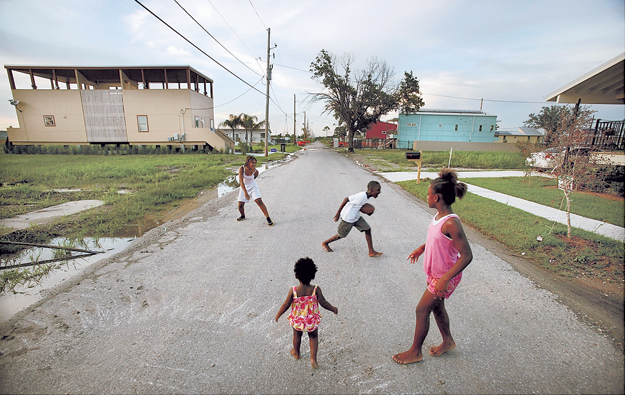 |
| Photo ' Mario Tama /Getty Images |
| Children playing football near their new home in August 2010. One of MIR's first projects was to partner with sustainable design firm BNIM, Kellogg's Corporate Citizenship Fund, PlayGreen Initiative, and KOMPAN, Inc. for an eco-playground a few blocks away from this street. |
GETTING IT RIGHT
Though many of the primary design recommendations were modified or cut to keep costs down or answer client needs, the MIR team struggled to stay true to the original concepts of the architects, all of whom donated their time and services to the foundation. 'In the evolution of each prototype, we strived to save money without sacrificing features that were critical to the intent of each design,' says Howell. The first generation of housing exceeded the target budget of $150,000 per house, but MIR was able to subsidize the additional cost with funding from other sources (grants, incentives, and donations). They are continuing to lower expenses, reaching $130 to $150 per square foot with the latest round of homes.
The site has become a living laboratory of sorts, with MIR testing different construction strategies and materials and monitoring and recording data on each component. Though it is difficult to compare the performance of the homes due to abundant variables (homeowner habits, window size, shading, orientation, etc.), MIR is keeping methodical records of energy use.
'The reason that some of the homes have hit zero net energy is largely due to the efficient envelope,' says Pierre Moses, MIR's product analyst. 'The solar is really just the icing on the cake.' Energy Star'rated appliances, efficient light fixtures, and homeowner education also help keep consumption down so the 3-to-4 kW photovoltaic systems provide the majority of electricity. Louisiana has one of the best residential tax credits for solar systems in the nation, according to Moses. 'Eighty percent of the cost comes back in the form of federal and state government subsidies, so it's a very attractive investment,' he explains. Before moving in, residents participate in educational courses about the green technologies in their new homes. 'It's a powerful thing for any community to have good energy habits as part of everyday life,' says Moses.
While the modern homes continue to sprout up around the site, work in the Lower Ninth Ward isn't finished by a long shot. MIR only controls one-third of the lots in their part of the ward, so they couldn't master-plan the site with amenities. 'Now that it's starting to feel like a neighborhood, we're turning more attention to the vacant lots. How do we make them community assets with usable, open spaces?' Darden continues, adding that MIR just received funding for a community garden.
In terms of infrastructure, the city just completed a test section of a street using a new pervious concrete that, if successful, could be implemented throughout the area. The city also approved funding to redo all of the streetscapes using rain gardens and bioswales. 'It will completely change the look and feel of the community when they've got new streets, sidewalks, and streetscapes,' says Darden. 'We don't have all the answers yet, but we're working with the residents to figure it out.'



Post a comment to this article
Report Abusive Comment